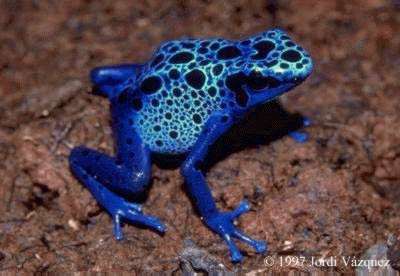Natural History
|
Why the Bright Colors? Poison Dart Frogs are known for their bright and vibrant displays of colors and there is a very good reason for that. While it may make them spectacularly beautiful, it serves a purpose. This aposematic or warning coloration lets potential predators or even curious hands know to watch out! While all Poison Dart frogs do indeed secrete poisons, only a few select frogs have the ability to provide a lethal dose to a human (Patocka et. al 1999). While many frogs are cryptically colored to blend into their environment, pictures such as the one at right show this is not the case with Poison Dart Frogs. Unlike many other frogs, they are diurnal in nature, letting their bright colors speak for themselves as they parade through the forests. Their ability to produce toxins adds a significant wallop to their diminutive size. The poison dart frogs range in size from a little over a centimeter to around five centimeters. These small frogs are found throughout the new world tropics of South and Central America (Myers and Daly 1983).
|
Dendrobates azureus. Photo courtesy of Jimmi Pedersen. |
|
Dendrobates tinctorius. Photo courtesy of Jimmi Pedersen |
Where do they live? Within this range they also exhibit a wide variety of exploitable habitats. "Some species are found along streams; others live away from water, on or near the ground in lowland or montane rain forest. A few forest species even spend most of their lives up in the trees. At the other extreme are a few species that live in open dry country..." (Myers and Daly 1983). Along with their variety in color and patterns, these frogs exhibit a wide variety of life histories. |


